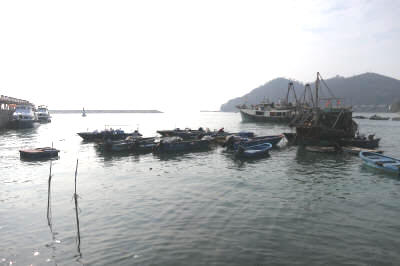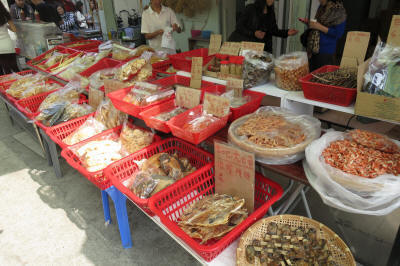Tai O Fishing Village
Tai O, often called the "Venice of Hong Kong," stands as one of Lantau Island's most captivating destinations and a living testament to Hong Kong's maritime heritage. This historic fishing village, established since at least the 16th century, remains home to the traditional Tanka people who have built their distinctive stilt houses (pang uk) over the tidal waters for generations. Today, Tai O represents a perfect blend of authentic cultural preservation and sustainable tourism, offering visitors an immersive experience into traditional Hong Kong coastal life.

Located on the northwestern tip of Lantau Island where the Pearl River estuary meets the South China Sea, Tai O's unique geography has shaped both its history and its character. The village sprawls across both riverbanks and waterways, with traditional stilt houses interconnected by narrow wooden boardwalks that create an intimate labyrinth of elevated walkways above the tidal waters.
Exploring the Stilt Houses and Waterways
Boat Tours and Water Experiences: The quintessential Tai O experience begins with a boat tour through the village's intricate waterway system. Local operators offer rides for HK$20-30 per person, taking visitors on 30-45 minute journeys through the channels between stilt houses. These small motorboats provide intimate access to see traditional fishing methods, observe daily village life, and capture stunning photographs of the historic architecture from water level.
🛥️ Premium Private Boat Charters
Luxury Full-Day Lantau Experiences combine Tai O's cultural heritage with premium comfort through private guided tours starting from HK$3,272. These comprehensive 7-8 hour experiences include hotel pickup, Ngong Ping cable car access, Big Buddha visits, and intimate Tai O boat tours with professional English-speaking guides. Highly rated at 4.96/5 stars, these exclusive tours provide personalized attention and insider access to traditional Tanka community life.
Private Charter Excellence: Full-day private Lantau tours featuring Tai O boat experiences are available starting from HK$3,272 (US$420) for highly-rated 7-8 hour experiences (4.96/5 from 81 reviews), while premium private options reach HK$4,750 (US$610) with perfect 5/5 ratings from 33 reviews. These comprehensive tours include hotel pickup, cable car access, Big Buddha visits, and personalized Tai O boat experiences with multilingual guides (English, Cantonese, Mandarin).
Cultural Immersion Charters focus on the authentic heritage experience, with specialist operators offering private access to traditional fishing techniques, behind-the-scenes village life, and exclusive interactions with the Tanka fishing community. These premium experiences emphasize cultural education and conservation awareness, perfect for discerning travelers seeking meaningful connections with Hong Kong's maritime heritage.
Pink Dolphin Watching: Many boat tour operators extend their services to include opportunities to spot the rare Chinese white dolphins (often called pink dolphins) that inhabit the waters around Lantau Island. These gentle marine mammals can sometimes be observed in their natural habitat, making Tai O an excellent starting point for wildlife enthusiasts.
🐬 Premium Pink Dolphin Experiences
Hong Kong DolphinWatch Ltd has been operating premium ecological tours since 1995, offering the region's most sophisticated pink dolphin watching experiences. Operating every Wednesday, Friday, and Sunday since 1995, their professional naturalist guides achieve an impressive 97% dolphin sighting success rate during 4-hour expeditions that include luxurious coach transfers from Tsim Sha Tsui, spacious double-decker vessels with onboard toilet facilities, insurance coverage, and comprehensive refreshment service with tea, coffee, and biscuits. The company guarantees a free repeat tour if no dolphins are sighted during your visit. At HK$580 for adults (HK$380 for children), these conservation-focused tours contribute directly to dolphin habitat protection while providing guests with unparalleled access to observe the world's pinkest wild dolphins in their natural Pearl River estuary habitat.
Private Charter Experiences elevate dolphin watching to exclusive luxury, with private yacht charters offering bespoke cultural excursions that combine traditional fishing village immersion with premium wildlife encounters. These personalized experiences include access to hidden temples, private cultural tours, and exclusive dining opportunities, creating what operators describe as "a deep dive into Hong Kong's soul." The unique geographical convergence of muddy Pearl River waters and clear South China Sea creates optimal viewing conditions near the spectacular Hong Kong-Zhuhai-Macao Bridge.
Cultural Heritage and Architecture
Traditional Tanka Community: The Tanka people, a traditional fishing community, have maintained their unique way of life in Tai O for centuries. Their stilt houses, built using traditional techniques and materials, demonstrate remarkable engineering adapted to tidal conditions. These elevated structures protect residents from flooding while providing direct access to the water for fishing activities.
Historic Bridges and Landmarks: The village features two notable bridges that serve as both functional infrastructure and popular photography locations. The Tai Chung Bridge operates as a drawbridge that opens to allow boats passage through the main waterway - a fascinating sight that showcases the village's living, working nature. The Sun Ki Bridge offers the classic postcard view of stilt houses against rolling green hills, making it the most photographed location in Tai O.
Culinary Delights and Local Specialties
Tai O Shrimp Paste: The village is renowned throughout Hong Kong for its distinctive shrimp paste, a fermented condiment that represents generations of traditional food preservation techniques. Visitors can observe the production process and purchase authentic products directly from local producers.

Street Food and Restaurants: Tai O offers exceptional culinary experiences ranging from street snacks to traditional restaurant dining. Cheung Choi Kee specializes in "husband rolls" (a Cantonese wordplay on shrimp and pork rolls), featuring the famous local shrimp paste. Fuk Hing Hong, located at the village entrance, serves popular fish balls, marinated cuttlefish, and tofu pudding that attract both tourists and locals. For fresh seafood, Tai O Store grills shrimp, cuttlefish, squid, oysters, and scallops over charcoal, providing authentic fishing village flavors.
Natural Beauty and Hiking Opportunities
Fu Shan Viewing Point: A moderate 20-minute hike along the Tai O Country Trail leads to the Fu Shan Viewing Point, which offers spectacular panoramic views across the village, surrounding waters, and on clear days, the impressive Hong Kong-Macau-Zhuhai Bridge spanning the Pearl River estuary.
Tung O Ancient Trail: Adventurous visitors can tackle the challenging 14.3-kilometer Tung O Ancient Trail, which connects Tung Chung to Tai O along Lantau's pristine northern coastline. This 3.5-4 hour hike provides dramatic coastal scenery and works up an appetite perfectly timed for Tai O's culinary offerings.
Accommodation and Extended Stays
Tai O Heritage Hotel: The crown jewel of Tai O accommodation, this boutique hotel occupies a meticulously restored 1902 colonial marine police station building that has been recognized by UNESCO. The heritage hotel offers free guided tours showcasing the building's history and provides afternoon tea featuring traditional Tai O delicacies. Staying overnight allows visitors to experience the village's tranquil evening atmosphere after day tourists depart.
Cultural Events and Festivals
Tai O Dragon Boat Water Parade: This UNESCO-recognized intangible cultural heritage event represents over a century of religious tradition. Sacred sampans carry temple statues through the waterways in a spectacular procession that demonstrates the deep spiritual connection between the Tanka community and the sea.
Tai O Lantern Festival: During the Mid-Autumn Festival, the village transforms with colorful handcrafted lanterns hung throughout the stilt house community, creating magical evening scenes that blend traditional celebration with stunning natural beauty.
Getting to Tai O
From Hong Kong Island/Kowloon: Take the MTR to Tung Chung Station, then board bus 11 for the scenic 45-minute journey to Tai O. Alternatively, take the ferry from Central Pier 6 to Mui Wo, then catch bus 1 to Tai O (also 45 minutes).
Direct Ferry Service: Tuen Mun offers direct ferry service to Tai O several times daily, providing a scenic water route that showcases Hong Kong's maritime heritage.
Visiting Tips: Allow 2-3 hours for a comprehensive Tai O experience, including boat tours, walking exploration, and dining. The village combines beautifully with visits to other Lantau attractions, making it an ideal component of a full-day island exploration. Early morning or late afternoon visits provide the best lighting for photography and fewer crowds for a more authentic experience.


